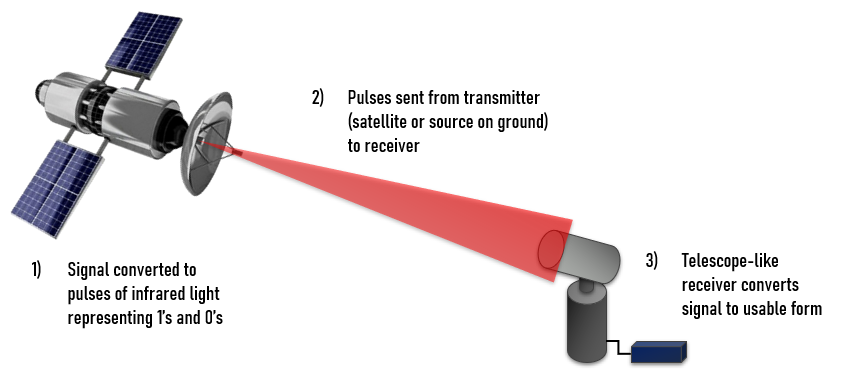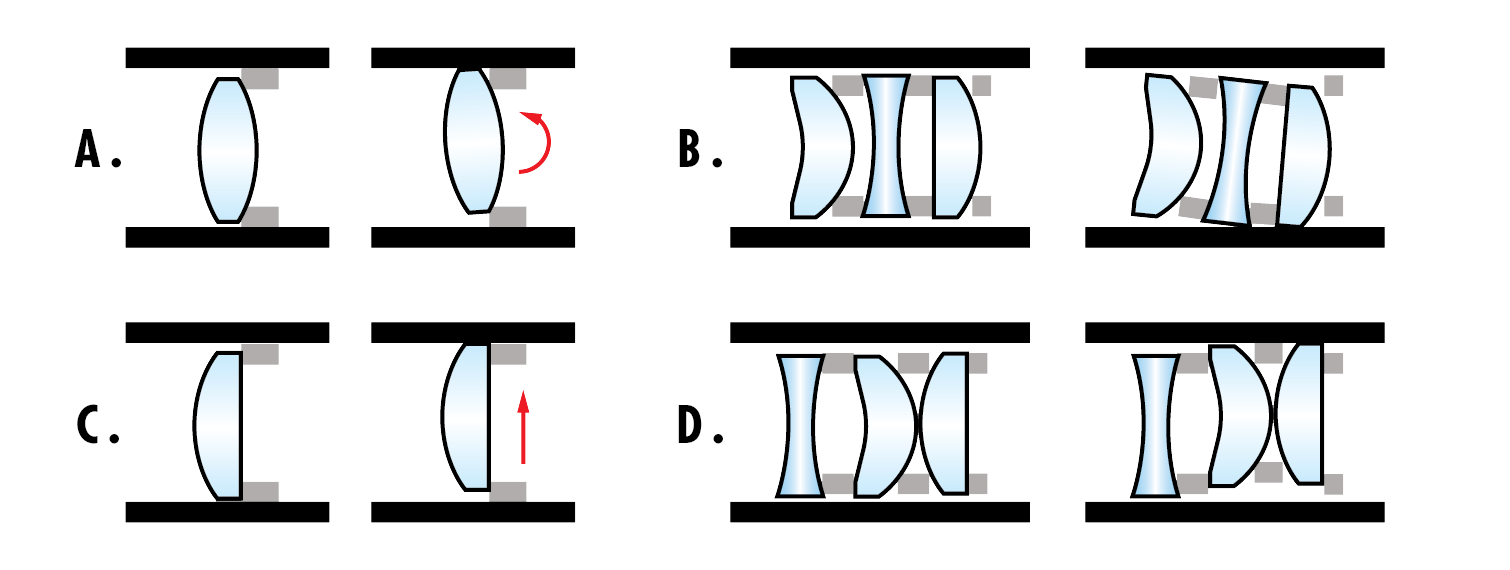
|
|
Wireless transmission of information through the air using lasers |
|
|
Much more bandwidth than radio-based wireless communication |
|
|
Enables fast, affordable internet that can reach rural areas or disaster sites |
|
|
Enables highly-secure communication for defense applications |
Fast, global communication is critical in our increasingly-connected world. The World Bank has declared that broadband internet access is a basic necessity for economic and human development, not a luxury.1 It opens up opportunities for education, employment, healthcare access, and government transparency and accountability that would be otherwise lost. Free-space optical (FSO) communication involves using lasers to transmit data from one location to another, whether it is from a satellite to a telescope-like ground station, one satellite to another, or between different locations on the ground (Figure 1). According to Global Market Insights, the FSO market will likely grow at a rate of over 35% in each of the next five years, skyrocketing from $200 million to $2 billion by 2027.2 In addition to fast internet access that can reach areas without optical fiber connections, FSO provides the means for highly-secure communications for defense applications that are difficult to intercept.

The World Bank estimates that 80% of the population of advanced economies have broadband high-speed internet access, while only 35% of the population in developing countries have broadband access.1 "Broadband" here is defined as internet faster than dial-up. FSO communication offers the potential for better wireless communication for groups that already have broadband internet access, as well as those that do not. Optical communication provides bandwidth increases of 10 – 100X compared to radio frequency (RF) wireless communication and requires less input power.3 The costs associated with setting up ground-based radio stations to receive FSO signals are also significantly less than installing new optical fiber connections because of the associated labor and digging costs. In some cases, it is also cheaper to use FSO communication from one location on the ground to another than to install optical fiber cables.
Current commercially-available FSO networks feature typical data rates ranging from 100 Mbps to 10 Gbps, while high-end prototypes report capacities as high as 160 Gbps.4 Many different companies are establishing networks of satellites that will facilitate high-speed, FSO-enabled communications (Figure 2). FSO communication offers a practical solution for creating global, broadband wireless connectivity.5

FSO communication is highly-advantageous for defense applications because of its increased level of security compared to RF or other wireless communication. FSO laser transmissions can be encrypted, are invisible or narrow-band, cannot be deciphered using RF meters or spectrum analyzers, propagate along a line-of-sight path which is difficult to intercept, and a matching FSO receiver is needed to collect the information.4 The receivers for FSO communication can also be designed to be mobile and easy to use, allowing them to be easily deployed in the field for defense applications. This facilitates fast, high-bandwidth, secure communication that can save lives.
Optical systems designed to receive FSO signals must be highly-sensitive, as atmospheric absorption, dispersion, the large distances between the transmitter and receiver, and scintillation make the ratio between the outgoing and incoming signal very large (Figure 3). Scintillation refers to rapid variations in the received signal because of the structure of the atmosphere through which the light propagates.6
| Weather | Wavelength, λ | Attenuation in dB at L Distance | ||
|---|---|---|---|---|
| 1 km | 10 km | 100 km | ||
| Conditions | microns | |||
| Clear weather (at sea level) | 0.53, 1.06 | 0.06 | 0.6 | 6 |
| 10.6 | 0.54 | 5.4 | 54 | |
| C02 absorption | 0.53, 1.06 | - | - | - |
| 10.6 | 0.25 | 2.5 | 25 | |
| Haze (Density: 0.1 mg/m3) |
0.53, 1.06 | 1.4 | 14 | 140 |
| 10.6 | 0.66 | 6.6 | 66 | |
| Light fog (Size: 0.5-10μ; density: 0.5 mg/m3; visability: ~2 km) |
0.53, 1.06 | 0.1-5 | 1-50 | 10-500 |
| 10.6 | .9 | 9 | 90 | |
| Fog (Size: 0.5-10μ; density: 1 mg/m3; visability: ~0.5 km) |
0.53, 1.06 | 0.2-10 | 2-100 | 20-1000 |
| 10.6 | 1.9 | 19 | 190 | |
| Rain 5mm/hr | 0.53, 1.06 | 1.6 | 16 | 160 |
| Rain 25mm/hr | 0.53, 1.06 | 4.2 | 42 | 420 |
| Rain 75mm/hr | 0.53, 1.06 | 0.7 | 7 | 70 |
| Light rain (Size: 1000μ; density: 50 mg/m3) | 10.6 | 1.6 | 16 | 160 |
| Light Snow | 0.53, 1.06 | 1.9 | 19 | 190 |
| Heavy Snow | 0.53, 1.06 | 6.9 | 69 | 690 |
The pointing accuracy and stability of the optical systems used for FSO are also critical. The narrow beam divergence inherent to laser-based communication (about 10X less than RF signals) makes pointing accuracy more important for FSO compared to traditional RF communications.8 Pointing accuracy requirements may typically be on the order of several hundred µrad, so extra gimbals or other steering mechanisms may be needed.9 Tight mechanical tolerancing in the optomechanical assembly design can help prevent movement of internal lens elements, which in turn improves pointing accuracy. The unwanted movement of lens elements inside the assembly can be described by roll, decenter, and the coupling of these effects from one element to another (Figure 4). More information can be found in our Tips for Designing Manufacturable Lenses and Assemblies Application Note. The algorithms used in FSO systems are also carefully tailored to better locate and receive the faint, narrow signals.

 Can obstructions like fog and vapor in the air interfere with free-space optical (FSO) communications?
Can obstructions like fog and vapor in the air interfere with free-space optical (FSO) communications?
 Does Edmund Optics® manufacture FSO systems?
Does Edmund Optics® manufacture FSO systems?
No, but Edmund Optics does manufacture optical components like the ones used in FSO systems.
or view regional numbers
QUOTE TOOL
enter stock numbers to begin
Copyright 2023 | Edmund Optics, Ltd Unit 1, Opus Avenue, Nether Poppleton, York, YO26 6BL, UK
California Consumer Privacy Acts (CCPA): Do Not Sell or Share My Personal Information
California Transparency in Supply Chains Act